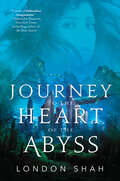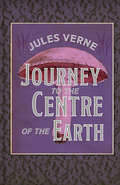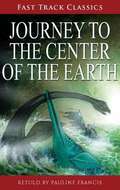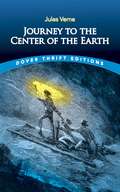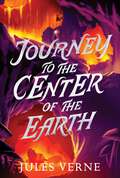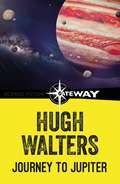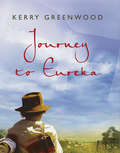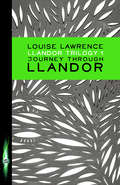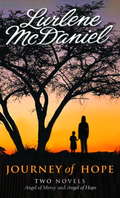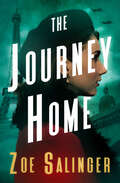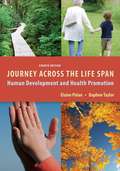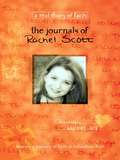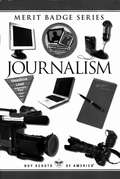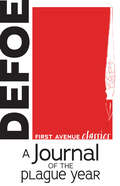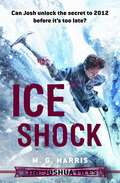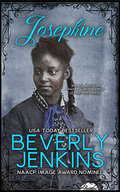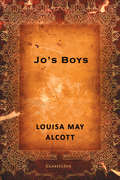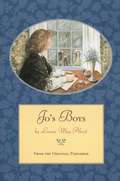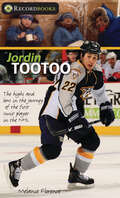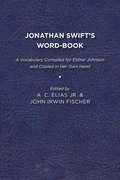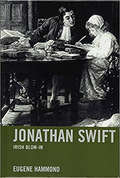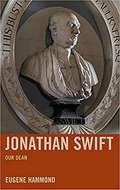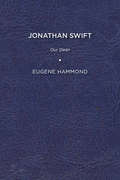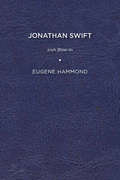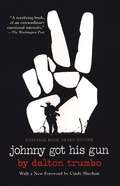- Table View
- List View
Journey to the Heart of the Abyss (Light the Abyss #2)
by London ShahThe sequel to London Shah's thrilling futuristic mystery The Light at the Bottom of the World, perfect for fans of Illuminae and These Broken StarsLeyla McQueen has finally reunited with her father after breaking him out of Broadmoor, the illegal government prison—but his freedom comes at a terrible cost. As Leyla celebrates his return, she must grapple with the pain of losing Ari. Now separated from the boy who has her heart and labeled the nation&’s number one enemy, Leyla must risk illegal travel through unchartered waters in her quest for the truth behind her father's arrest.Across Britain, the fallout from Leyla's actions has escalated tensions between Anthropoid and non-Anthropoid communities, bringing them to an all-time high. And, as Leyla and her friends fight to uncover the startling truths about their world, she discovers her own shocking past—and the horrifying secrets behind her father&’s abduction and arrest. But as these long-buried truths finally begin to surface, so, too, do the authorities&’ terrible future plans. And if the ever-pervasive fear prevents the people from taking a stand now, the abyss could stay in the dark forever.
Journey to the Centre of the Earth (Classics With Ruskin Series #Vol. 4)
by Jules VerneOriginally published in 1864, this classic science fiction novel is simultaneously a perilous adventure into the earth’s core and a reflection on the perfectibility of human understanding and psychology of explorers. The intrepid Professor Lidenbrock and his nervous nephew Axel decode a scrap of paper written in runic script and embark on the strangest expedition of the nineteenth century. Enlisting the silent Hans as their guide, they travel across Iceland to find the secret passage to the centre of the earth via an extinct volcano, finding in it an astonishing subterranean menagerie of natural hazards, prehistoric beasts and sea monsters, and curious sights. Penguin Random House Canada is proud to bring you classic works of literature in e-book form, with the highest quality production values. Find more today and rediscover books you never knew you loved.
Journey to the Center of the Earth: Mandarin Companion Graded Readers: Level 2, Traditional Chinese Edition (Foundation Classics Ser.)
by Pauline Francis Jules Verne Gary AndrewsNIMAC-sourced textbook
Journey to the Center of the Earth (Dover Thrift Editions)
by Jules VerneAn adventurous geology professor chances upon a manuscript in which a 16th-century explorer claims to have found a route to the earth's core. Professor Lidenbrock can't resist the opportunity to investigate, and with his nephew Axel, he sets off across Iceland in the company of Hans Bjelke, a native guide. The expedition descends into an extinct volcano toward a sunless sea, where they encounter a subterranean world of luminous rocks, antediluvian forests, and fantastic marine life — a living past that holds the secrets to the origins of human existence.Originally published in 1864, Jules Verne's classic remains critically acclaimed for its style and imaginative visions. Verne wrote many fantasy stories that later proved remarkably prescient, and his distinctive combination of realism and romanticism exercised a lasting influence on writers as diverse as Mark Twain, Arthur Conan Doyle, and Jean-Paul Sartre. In addition to the excitement of an action novel, Journey to the Center of the Earth has the added appeal of a psychological quest, in which the sojourn itself is as significant as the ultimate destination.
Journey to the Center of the Earth: The Original Edition (The Jules Verne Collection)
by Jules VerneJourney to a prehistoric world at the center of the Earth in this science fiction classic by Jules Verne—now with an arresting new look!When Axel&’s uncle, Professor Liedenbrock, finds a coded journal describing a path into the center of the Earth, Axel hopes he&’ll never be able to decipher it—because once the professor sets his mind to something, he&’ll insist on carrying it out no matter the danger or difficulty. But when Axel himself ends up cracking the journal&’s code, curiosity gets the better of him, and before he knows it, he and his uncle head to Iceland to find this secret route to unexplored territory. After being joined by a local guide, Hans, the group descends into a volcano, where Axel is convinced they&’ll find nothing noteworthy and face nearly certain death. Instead, what awaits is more incredible than any of the travelers could have anticipated.
Journey to Jupiter
by Hugh WaltersChris and his friends are setting off on the first trip ever to be made to the planet Jupiter. One thing puzzles them - they have been given no details of the time the flight will take. But as the space ship continues on its journey they are told that they will travel at higher speeds than have ever been achieved before. The effects of the tremendous speed turn out to be much more serious than expected...
Journey to Eureka
by Kerry GreenwoodThere are people in the world who will hurt you because they can and they like it: and there are people who will help you because they can and they like it. It is 1854 - Llew Jones swindles his way on board the Great Britain as it sets sail for Australia, anxious to find his mother and uncle who have been sent there. After several long months at sea, Llew finally reaches Australian shores with new friends and the prospect of a new home at the goldfields near Ballarat. But his journey has only just begun. Old enemies are waiting and a violent and bloody battle called the Eureka Stockade threatens to destory his new-found happiness forever.
Journey Through Llandor
by Louise LawrenceThe first book of Louise Lawrence's gripping Llandor Trilogy.Roderick, Carried and Craig - on their chase through the forest - find themselves crashing into a frighteningly alien world of terrifying monsters and strange beings. Unable to find their way out, they are befriended by Janine, the elf girl, and many others, as they are forced headlong into a flight through Llandor, pursued by the evil presence of the Grimthane.
Journey of Hope: Two Novels
by Lurlene McdanielContains two novels: Angel of Mercy & Angel of Hope<P> HEATHER BARLOW HAS always been idealistic, and now that she has finished high school, she's ready to make a difference in the world. After graduation she joins a mission group on a hospital mercy ship sailing to Africa.
The Journey Home
by Zoe SalingerIn this multigenerational family saga, a woman falls for a handsome French stranger, only to discover their families share a tragic Holocaust history. Dominique Rappaport, New York heiress to her family&’s art world fortune, wants more out of life than fancy society parties. More than the man her parents want her to wed for the sake of the business merger their marriage would bring. Still, Dominique travels to Paris to spend time with Pierre, only to find herself drawn to another man . . . A struggling medical student, Julian Adler wants nothing to do with Dominique. After all, Julian has his grandfather&’s legacy of heroism during the French Resistance to live up to. He doesn&’t have time for the haughty beauty, no matter how much she intrigues him. Until chance brings them together once more, and a mutual attraction draws them closer. But when Dominique discovers the tragedy that binds their families together, will their love be enough to rise above it?
Journey Across the Life Span: Human Development and Health Promotion
by Elaine U. Polan Daphne R. TaylorAs health care delivery changes, there is a growing emphasis on health promotion, maintenance, and restoration for individuals in a variety of settings. Elaine Polan and Daphne Taylor s book addressees those needs as it guides students through the life cycle from conception to old age. Through user-friendly chapters and new, four-color presentation, they provide LPN/LVN students with a complete review of growth and development across the lifespan.
The Journals of Rachel Scott
by Beth NimmoWritten teen to teen as a first-person narrative, this is not a book about the Columbine shootings - instead, it's a story of faith, told in Rachel's own words. The book includes first person narratives, journal entries, drawings from Rachel's diary, and notes from her parents and friends at Columbine High School. Additionally, "me pages" (what makes me angry, what I'm afraid of) encourage teens to explore issues central to their lives and faith. Highlighting Rachel's faith journey from the time she became a Christian, through her joys and doubts, her hopes and dreams, this story is a triumphant testimony that teens will treasure.
Journalism (Merit Badge Series)
by Boy Scouts of America StaffEnhancing our youths' competitive edge through merit badges
A Journal of the Plague Year (First Avenue Classics ™)
by Daniel DefoeFirst published in 1722, this unabridged edition of Daniel Defoe's A Journal of the Plague Year covers events in London, England, in 1665 as the bubonic plague spread throughout the city. Though a work of historical fiction, the book includes accurate historical details, charts, statistics, and government documents. Defoe's narrator follows the spread of the plague and relates how powerful families and government officials tried to hide the disease to avoid inconvenience and public panic. But as deaths mounted and fear spread, those who could began to flee the city. A Journal of the Plague Year continues to resonate with modern audiences through its parallels to issues caused by modern diseases and the COVID-19 pandemic.
The Joshua Files: Ice Shock
by M. G. HarrisThough he knows about the secret Mayan prophesy that his father and grandfather were a part of, Josh still hasn't solved the mystery surrounding his father's death. But when Josh learns that a special artifact, the Bracelet of Itzamna, is the key to both that and the mystery of the codex, he must return to the hidden city of Ek Naab. Only this time he must do it alone-because as the stakes rise, Josh can no longer trust even his closest allies. This second installment of the action-packed Joshua Files series brings readers back to the secret world of the Mayan civilization, where the mysterious 2012 prophecy still threatens the world. Does Josh have what it takes to make it out alive once again?
Josephine (Avon True Romance Series)
by Beverly JenkinsJosephine ‘Jojo’ Best has it all figured out. Just seventeen, she's been to college, she has her own hairdressing shop and nothing will distract her from her goals. That is, until handsome George Brooks begins to pursue her. Then the return of her childhood nemesis complicates her life even further! <P><P>No girl is immune to Adam Morgan’s charm. But when a wound brings him home from the War Between the States, it’s a girl he used to call “Pest” who’s turning the tables. All grown up, Jojo is being courted by another soldier, and Adam knows it would be foolish to play with her heart; but he just can’t get the ugly duckling turned swan off his mind. <P><P>Jojo, too, can't deny her growing feelings for Adam. But he's always been such a flirt—how can she take him seriously? He can't possibly be serious about her. Besides, she has George falling all over himself to please her. As the war rages on, Adam's feelings for Jojo grow stronger, but Jojo's determination to resist him does, too. One thing is clear, though: Jojo is a girl who always gets what she wants, even when she doesn’t know what it is!
Jo's Boys: And How They Turned Out
by Louisa AlcottThe little men of Plumfield are now grown and making their ways in the world. But even as their pursuits take them far from home, "Mother" Jo March continues to play an inspiring and steadying role in their lives.Through adventures great and small, Tommy, Emil, Demi, Nat, Dan, and the rest of the March children experience love and loss, but never forget the lessons they learned from Meg, Jo, and Amy March—the little women who have guided them from childhood.Be it mystery, romance, drama, comedy, politics, or history, great literature stands the test of time. ClassicJoe proudly brings literary classics to today's digital readers, connecting those who love to read with authors whose work continues to get people talking. Look for other fiction and non-fiction classics from ClassicJoe.
Jo's Boys: How They Turned Out
by Louisa May AlcottThis sequel to Alcott's "Little Women" and "Little Men" chronicles the return of the classmates of Plumfield, Jo's school for boys. Readers re-encounter Nat, the orphaned street musician, now a conservatory student; restless Dan, back from the gold mines of California; business-minded Tom; and other old friends.
Jordin Tootoo: The Highs and Lows in the Journey of the First Inuk to Play in the NHL (Lorimer Recordbooks)
by Melanie FlorenceJordin Tootoo is known for having to "fight his way through." Jordin had more than his fair share of fights both on and off the ice. He had to overcome the social problems that are associated with the far north, fight his way through the discrimination and culture shock he encountered after leaving his remote community to play in the Juniors, and see his way through the grief of losing his NHL-bound older brother and hero, Terence Tootoo, to suicide in 2002. From a small rink in the Arctic Circle, to joining the Nashville Predators in 2001 and becoming an NHL hero, this is the story of the highs and lows of the first Inuk to play in the NHL. Distributed in the U.S by Lerner Publishing Group
Jonathan Swift's Word-Book: A Vocabulary Compiled for Esther Johnson and Copied in Her Own Hand
by A. C. Elias Jr. John Irwin FischerThis Word-Book is presumably the only work of Jonathan Swift’s not in print, until now. Since the 1690s, Swift had been formulating a list of words and definitions for his protégé Esther Johnson, beginning with terms from the Book of Common Prayer. His was apparently an ongoing list, kept rather haphazardly, with open spaces for adding new words. About 1710, when Swift was in London, Johnson, in Dublin, set out to formalize the dictionary, copying out Swift’s words and definitions to make an orderly and careful book with no blank spaces. Probably in 1713, when Swift returned to Ireland, Johnson presented her Word-Book to him, but his school-masterly corrections of her work may have offended her. After Johnson’s death in 1728, Swift gave the Word-Book to their mutual friend, Elizabeth Sican. It was passed down over generations, until in 1976, the young American Swiftian A. C. Elias, Jr., bought it, intending to edit it in his old age. Before his early death in 2008, Elias asked John Fischer to assume the challenge of bringing the book into print. Fischer took on the task until 2015, when he too passed away, after which his wife Panthea Reid completed the task. This volume includes illustrations from the original book, a transcript of it with schematic indications of Swift’s corrections, as well as essays and appendices by Fischer and Elias tracing provenance, exploring the social and psychological milieu in which the book was written, and tracking Swift’s work as a lexicographer. Published by University of Delaware Press. Distributed worldwide by Rutgers University Press.
Jonathan Swift: Irish Blow-In
by Eugene HammondJonathan Swift: Irish Blow-in covers the arc of the first half of Jonathan Swift’s life, offering fresh details of the contentment and exuberance of his childhood, of the support he received from his grandmother, of his striking affection for Esther Johnson from the time she was ten years old (his pet name for her in her twenties was “saucebox”), of his precocious entry into English politics with his Contests and Dissensions pamphlet, of his brilliant and much misunderstood Tale of a Tub, and of his naive determination to do well both as a vicar of the small parish of Laracor in Ireland and as a writer for the Tory administration trying to pull England out of debt by ending the war England was engaged in with France. I do not share with past biographers the sense that Swift had a deprived childhood. I do not share the suspicion that most of Swift’s enmities were politically motivated. I do not feel critical of him because he was often fastidious with his money. I do not think he was insincere about his religious faith. His pride, his sexual interests, his often shocking or uninhibited language, his instinct for revenge – emphasized by many previous biographers – were all fundamental elements of his being, but elements that he either used for rhetorical effect, or that he tried to keep in check, and that he felt that religion helped him to keep in check. Swift had as firm a conviction as did Freud that we are born with wayward tendencies; unlike Freud, though, he saw both religion and civil society as necessary and helpful checks on those wayward tendencies, and he (frequently, but certainly not always) acknowledged that he shared those tendencies with the rest of us. This biography, in two books, Jonathan Swift: Irish Blow-in and Jonathan Swift:Our Dean, will differ from most literary biographies in that it does not aim to show how Swift’s life illuminates his writings, but rather how and why Swift wrote in order to live the life he wanted to live. I have liberally quoted Swift’s own words in this biography because his inventive expression of ideas, both in his public works and in his private letters, was what has made him a unique and compelling figure in the history of literature. I hope in these two books to come closer than past biographies to capturing how it felt to Swift himself to live his life. Published by University of Delaware Press. Distributed worldwide by Rutgers University Press.
Jonathan Swift: Our Dean
by Eugene HammondJonathan Swift: Our Dean details the political climax of his remarkable career—his writing and publication of The Drapier’s Letters (1724), Gulliver’s Travels (1726), and A Modest Proposal (1729)—stressing the relentless political opposition he faced and the numerous ways, including through his sermons, that he worked from his political base as Dean of St. Patrick’s Cathedral, psychologically as well as physically just outside the Dublin city walls, to attempt to rouse the Irish people to awareness of the ways that England was abusing them. This book faces squarely the likelihood that Swift had a physical affair with Esther Vanhomrigh between 1719 and 1723, and reassesses in the light of that likelihood his conflicting relations with Esther Vanhomrigh and Esther Johnson. It traces the many loving friendships with both men and women in Ireland that sustained Swift during the years when his health gradually failed him, enabling him to continue indefatiguably, both through his writings and his authority as Dean of St. Patrick’s, to contribute to the public welfare in the face of relentless British attempts to squeeze greater and greater profits out of their Irish colony. Finally, it traces how Swift’s political indignation led to his treating many people, friends and enemies, cruelly during the 1730s, even while his humor and his ability to make and attract new friends sustained themselves until his memory finally failed him in 1742. This biography, in two books, Jonathan Swift: Irish Blow-in and Jonathan Swift:Our Dean, comes closer than past biographies to capturing how it felt to Swift himself to live his life. Published by University of Delaware Press. Distributed worldwide by Rutgers University Press.
Jonathan Swift: Our Dean
by Eugene HammondJonathan Swift: Our Dean details the political climax of his remarkable career—his writing and publication of The Drapier’s Letters (1724), Gulliver’s Travels (1726), and A Modest Proposal (1729)—stressing the relentless political opposition he faced and the numerous ways, including through his sermons, that he worked from his political base as Dean of St. Patrick’s Cathedral, psychologically as well as physically just outside the Dublin city walls, to attempt to rouse the Irish people to awareness of the ways that England was abusing them. This book faces squarely the likelihood that Swift had a physical affair with Esther Vanhomrigh between 1719 and 1723, and reassesses in the light of that likelihood his conflicting relations with Esther Vanhomrigh and Esther Johnson. It traces the many loving friendships with both men and women in Ireland that sustained Swift during the years when his health gradually failed him, enabling him to continue indefatiguably, both through his writings and his authority as Dean of St. Patrick’s, to contribute to the public welfare in the face of relentless British attempts to squeeze greater and greater profits out of their Irish colony. Finally, it traces how Swift’s political indignation led to his treating many people, friends and enemies, cruelly during the 1730s, even while his humor and his ability to make and attract new friends sustained themselves until his memory finally failed him in 1742. This biography, in two books, Jonathan Swift: Irish Blow-in and Jonathan Swift:Our Dean, comes closer than past biographies to capturing how it felt to Swift himself to live his life. Published by University of Delaware Press. Distributed worldwide by Rutgers University Press.
Jonathan Swift: Irish Blow-In
by Eugene HammondJonathan Swift: Irish Blow-in covers the arc of the first half of Jonathan Swift’s life, offering fresh details of the contentment and exuberance of his childhood, of the support he received from his grandmother, of his striking affection for Esther Johnson from the time she was ten years old (his pet name for her in her twenties was “saucebox”), of his precocious entry into English politics with his Contests and Dissensions pamphlet, of his brilliant and much misunderstood Tale of a Tub, and of his naive determination to do well both as a vicar of the small parish of Laracor in Ireland and as a writer for the Tory administration trying to pull England out of debt by ending the war England was engaged in with France. I do not share with past biographers the sense that Swift had a deprived childhood. I do not share the suspicion that most of Swift’s enmities were politically motivated. I do not feel critical of him because he was often fastidious with his money. I do not think he was insincere about his religious faith. His pride, his sexual interests, his often shocking or uninhibited language, his instinct for revenge – emphasized by many previous biographers – were all fundamental elements of his being, but elements that he either used for rhetorical effect, or that he tried to keep in check, and that he felt that religion helped him to keep in check. Swift had as firm a conviction as did Freud that we are born with wayward tendencies; unlike Freud, though, he saw both religion and civil society as necessary and helpful checks on those wayward tendencies, and he (frequently, but certainly not always) acknowledged that he shared those tendencies with the rest of us. This biography, in two books, Jonathan Swift: Irish Blow-in and Jonathan Swift: Our Dean, will differ from most literary biographies in that it does not aim to show how Swift’s life illuminates his writings, but rather how and why Swift wrote in order to live the life he wanted to live. I have liberally quoted Swift’s own words in this biography because his inventive expression of ideas, both in his public works and in his private letters, was what has made him a unique and compelling figure in the history of literature. I hope in these two books to come closer than past biographies to capturing how it felt to Swift himself to live his life. Published by University of Delaware Press. Distributed worldwide by Rutgers University Press.
Johnny Got His Gun: Johnny Cogió Su Fusil (Film Ink Ser.)
by Dalton TrumboThis is no ordinary novel. This is a novel that never takes the easy way out: it is shocking, violent, terrifying, horrible, uncompromising, brutal, remorseless and gruesome...but so is war. Written from the perspective of one man's thoughts, often a stream of consciousness with its own punctuation style, even the title takes on new meaning. Published in 1939, the book itself has a history, partially described by the author in introductions in 1959 and 1970. A compelling novel about war that is still relevant today, this story is not to be missed. Note: The author does not follow standard American spelling.
